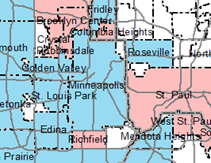The Metropolitan Council analyzes tax-base sharing to share results and increase awareness of the program. Analysis also helps the Council and the Minnesota Department of Revenue determine which communities participate in the program, as required each year by state law. To be fair, communities whose planning and zoning policies exclude most commercial-industrial development, for reasons other than preserving agriculture, cannot participate in the program.
How it impacts communities
Tax-base sharing narrows the gap between communities with the highest and the lowest commercial, industrial, and public utility property tax base per person. For communities with over 10,000 people, the difference is 6 to 1 with tax-base sharing and 16 to 1 without it. 
More communities gain tax base (104 net recipients) than lose tax base (73 net contributors). For net recipients, the distribution from the shared pool of tax base exceeds the contribution to the shared pool.
The top 20 net contributors concentrate near major highways and job centers.
How It Affects Commercial-Industrial Property
Part of a commercial, industrial, or public utility property is taxed at an areawide rate, and the rest is taxed at the local rate. The area-wide tax rate reduces differences in tax rates across the metro area.